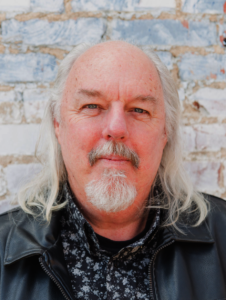Home
 Considered by his peers “a master,” artist Clifford Land paints “realistically by mastering light and shadow. His work coined as hyper-realism, his work often entails a softer, much more complex focus of his subject depicted in his painting, no matter how small or billboard size. These paintings are meticulously detailed to create the illusion of a reality not seen in the original photo source or subject.”
Considered by his peers “a master,” artist Clifford Land paints “realistically by mastering light and shadow. His work coined as hyper-realism, his work often entails a softer, much more complex focus of his subject depicted in his painting, no matter how small or billboard size. These paintings are meticulously detailed to create the illusion of a reality not seen in the original photo source or subject.”
Land became a journeyman pictorial artist, which gave him contracted billboard work for over a dozen years, dangling from buildings like Spider-Man to beautify exteriors with a more commercial appeal. He also developed other skill-sets – like “faux finishing” used to remodel a casino or master copying works irreparably damaged. Various jobs had him serving as an art director for a printing plant or fulfilling the needs of an advertising agency that handled all the Chevy dealerships in the Houston metro area, which proved to be draining for him.
Admission into Atlanta’s Piedmont Art Festival had Land bring a realism touch to “suburban poverty,” and the display turned the head of famous New York artist Mark Kostabi, whom Clifford had recognized from Lifestyles of the Rich and Famous. Kostabi would encourage Land to visit the studio in NYC. The following autumn,
Clifford’s visit to the Big Apple’s art scene meant immediate offers from that included sub-contracting gigs from Kostabi himself. Wanting the full opportunity to network with those painters more prominent in the city’s creative community, Land’s move to New York meant work painting billboards again, and a re-evaluation of the consideration of “fine art” that snobbishly excluded commercial works. The move meant meeting contemporaries like Ron English or Gerhard Richter, and the billboard projects became larger and more complex, like a 100×200 foot display in Brooklyn’s Bruckner Highway featuring large cartoon heads or a large “Michael Jordan” type basketball figure in which rich fleshly a painted human figure extended approximately 120’ tall that would eventually become landmarks.

 New York saw what many would consider to be land’s most recognizable work – the infamous DKNY mural on Houston St (pronounced “house ton”). Remaining visible for 17 years and receiving a global amount of attention, Land was originally chose to paint the Soho wall mural ad by Transportation Display Inc. The advertising agents at DKNY were rigorous about their specifications in the historic neighborhood, desiring that their final design. With assistant Bill Sutphen, Land executed the wall design within 10 working days during the early spring, completing the project three weeks under the projected deadline.
New York saw what many would consider to be land’s most recognizable work – the infamous DKNY mural on Houston St (pronounced “house ton”). Remaining visible for 17 years and receiving a global amount of attention, Land was originally chose to paint the Soho wall mural ad by Transportation Display Inc. The advertising agents at DKNY were rigorous about their specifications in the historic neighborhood, desiring that their final design. With assistant Bill Sutphen, Land executed the wall design within 10 working days during the early spring, completing the project three weeks under the projected deadline.
